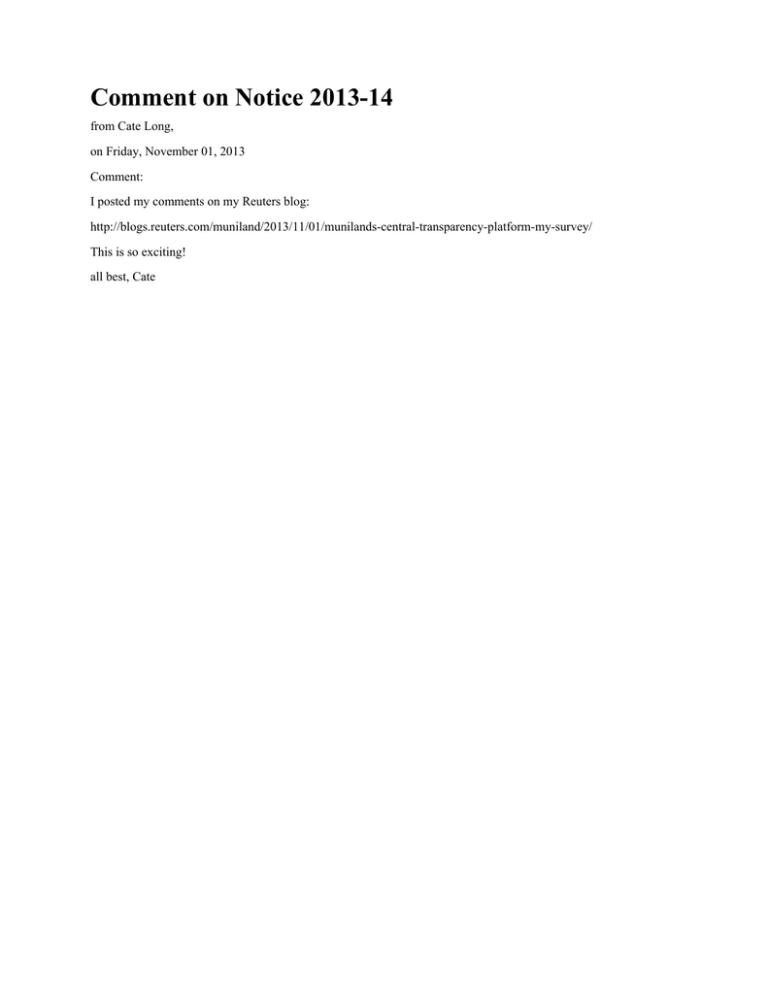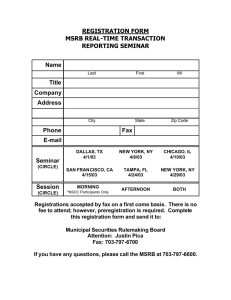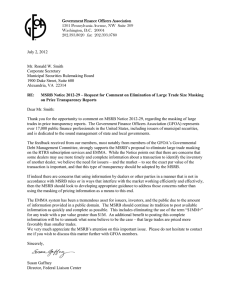
Comment on Notice 2013-14
from Cate Long,
on Friday, November 01, 2013
Comment:
I posted my comments on my Reuters blog:
http://blogs.reuters.com/muniland/2013/11/01/munilands-central-transparency-platform-my-survey/
This is so exciting!
all best, Cate
11/1/13
MuniLand » Muniland’s Central Transparency Platform: My survey » Print
This copy is for your personal, non-commercial use only. To order presentation-ready copies for distribution
to colleagues, clients or customers, use the Reprints tool at the top of any article or visit:
www.reutersreprints.com.
Muniland’s Central Transparency Platform:
My survey
November 1, 2013 @ 2:37 pm
By Cate Long
[1]
The MSRB has published a concept release [2] about how it should design the new Central
Transparency Platform (CTP). For the first time ever in muniland it will also gather and collect
information on bids and offers before bond transactions occur (pre-trade). This information will
be made available to the public. Here is how the MSRB describes the project:
With respect to pre-trade price transparency, there is currently no central location
in the municipal market through which such pricing information is made broadly
available to the public in a comprehensive manner. To the extent that pre-trade
pricing information is available, it is typically provided by electronic networks
operated by broker’s brokers, alternative trading systems (ATS) and other similar
systems,[7] [3] although such information also has sometimes been provided
through non-electronic venues as well.
Typically, access to pre-trade pricing information is limited to market participants
engaging directly with such venues and may be further limited to information
regarding only those potential transactions involving the particular market
participant, with information consisting of some or all of the bids and offers entered
for a potential transaction.
The MSRB’s Long-Range Plan envisions that the CTP would serve as the nextgeneration of RTRS and would include, in addition to enhanced public access to
blogs.reuters.com/muniland/2013/11/01/munilands-central-transparency-platform-my-survey/?print=1&r=
1/5
11/1/13
MuniLand » Muniland’s Central Transparency Platform: My survey » Print
real-time post-trade pricing information, new centralized public access to pre-trade
pricing information, as well as related disclosure information, yield curves and other
utilities for public users of the information.
This development is revolutionary for the municipal bond market. It will help non-dealer
investors assess the fairness of prices they are being offered on a security. This will be the most
significant step for municipal bond trading since the MSRB RTRS trade reporting system [4] was
established.
Here are my responses to some of the questions in the Concept Release (in bold):
Consistency of Transaction Price Reporting
Currently principal trades (with the dealer markup included) are reported to the
MSRB at the price they are done. Agency trades are reported as the trade price
plus the dealer commission. The MSRB then calculates the yield for these trades.
Should the MSRB require trades done in wrap accounts (annual maintenance fee
accounts, often investment advisor accounts) to be reported with a special
indicator? Yes.
Should MRSB require disclosure of wrap fees? Yes, but it would not be possible to
extrapolate the fee to individual bond trades.
Market of Execution
The MSRB currently identifies all transactions executed by a broker’s broker [aka
interdealer brokers]. This identifier is applied based on the broker’s broker
informing the MSRB that it acts in such capacity. The MSRB does not currently
identify trades executed through an ATS [alternative trading system like Bonddesk
or The MuniCenter].
Should the MSRB require dealers effecting transactions through an ATS to
include an indicator to that effect? Yes.
Should such indicator be included in the information disseminated publicly?
Yes. If trades done on an ATS gave investors better prices they could
request their order be routed there.
Are there other venues through which dealers effect transactions that should
be reflected by an indicator? OTC trades (dealer to dealer) should be
identified.
For any trades subject to a venue indicator, would it be sufficient to indicate
the type of venue or should dealers be required to identify the specific
venue? The specific ATS or venue should be identified. The information
should be collected for compliance (best execution) and eventually for
transparency purposes.
What would be the benefits and burdens of establishing such a requirement?
It is always done on equity trades and would be easily possible to collect
and disseminate for bond trades.
Is the existing broker’s broker indicator included on disseminated information
useful? Yes, some market participants use it to gauge dealer trading book
changes.
Would a greater level of precision in the application of the broker’s broker
identifier be appropriate such that the dealers transacting with the broker’s
broker and/or the broker’s broker itself include an identifier on the trade
report to signify that the transaction was executed by a broker’s broker in its
capacity as such? Yes.
Transactions with Affiliated Entities
In recent years, some dealers have informed the MSRB that new corporate
structures have been formed whereby some dealers establish several distinct
corporate entities to perform specific functions.
For example, some corporate structures involve one corporate entity that holds
inventory and another corporate entity that transacts with customers [see Fidelity].
In these cases, the corporate entity that transacts with customers will acquire
bonds from or sell liquidated positions to the corporate entity that holds inventory
blogs.reuters.com/muniland/2013/11/01/munilands-central-transparency-platform-my-survey/?print=1&r=
2/5
11/1/13
MuniLand » Muniland’s Central Transparency Platform: My survey » Print
on an exclusive basis. Given the mechanical nature of these intra-corporate entity
transactions and the fact that the prices at which these transactions occur are
based on set arrangements raises questions about whether such transactions
reflect negotiated arms-length transactions priced based on current market
conditions. The MSRB seeks comment on the following:
To what extent have dealers employed such corporate structures where
transactions occur between two separate legal entities on an exclusive basis
at prearranged pricing arrangements? Unknown.
Are there other arrangements among dealers that present similar
transaction reporting issues? Any dealer internalization of order flow.
Should transactions arising from these corporate structures be identified as
being “away from market” transactions or should a new indicator be used for
identifying such transactions when they are reported? A new indicator
should be used so the MSRB can track the frequency and fairness of these
transactions.
If a new indicator is used, should such transactions continue to be
disseminated publicly and include this new indicator? Yes, investors should
be able to locate a trade they made on the trade tape even if done
between two entities of the same corporate structure.
Potential collection and dissemination of pre-trade information
Would collection and public dissemination of additional pre-trade
transparency by the MSRB improve pricing efficiency, investor confidence and
liquidity in the market place? Hallelujah. Angels will be singing.
Would providing such information publicly have any negative impacts on
market participants or the marketplace in general? Yes, over time dealer
mark-ups will be reduced.
As an alternative to the MSRB collecting such information for public
dissemination through the EMMA website, are there existing venues for
public access to all or some of this information? Not really for retail
investors.
Do daily bids and offers available through these existing venues provide a
true and reliable indication of market levels? Some bids and offers are
indicative and not executable.
Would providing access to these existing venues through the EMMA website,
rather than providing the pre-trade information itself through the EMMA
website, meet the MSRB’s stated objectives for providing access to this
information to the public? No, the MSRB has the capacity to determine
yields and scrub data. Vital for investors.
Would any of these venues provide access to issuers and investors, including
retail investors, at no cost? Not if the dealers have their way.
Are there other alternatives to achieving the goals of broadly available pretrade price transparency that would be more effective or less burdensome
than those described in this concept release? No.
What types of information or tools should be provided along with the pretrade information itself to help the public understand the nature and
potential uses of the information? Yield curves are useful.
Technology and Protocols for Collecting Pre-Trade Information
In the January 2013 Concept Release, the MSRB sought input on certain baseline
technology, processes and protocols relating to some of the potential new data
elements or data types that might be included in the CTP to assist the MSRB in
pursuing a CTP architecture that can support a broad array of data types in a
manner that is most efficient for the MSRB as well as for market participants who
may have a role in the submission or dissemination of such data.
In particular, in connection with the potential collection of pre-trade information, the
MSRB sought input on the most effective methods currently used to disseminate
such information among market participants, and whether such methods would be
appropriate for the purposes of the CTP. The MSRB received only limited comments
on these issues. The MSRB again seeks comment on these types of technology and
protocol issues with respect to pre-trade information. Specifically:
blogs.reuters.com/muniland/2013/11/01/munilands-central-transparency-platform-my-survey/?print=1&r=
3/5
11/1/13
MuniLand » Muniland’s Central Transparency Platform: My survey » Print
The MSRB understands that the FIX messaging protocol [20] [5] is commonly
used in the fixed income market for purposes of entering bids and offers. Is
there any reason why the FIX messaging protocol would not be appropriate
for purposes of submitting pre-trade information to the MSRB? There is no
reason not to use this well established electronic trading protocol. [6] FIX
is perfect for transmitting bids, offers, executions, confirmations and all
stages of the trade cycle.
Are there alternative messaging protocols, and what are the relative merits
of available alternatives as compared to the FIX messaging protocol? No.
If the FIX messaging protocol is the appropriate method of collecting pretrade pricing information, are there certain data fields, in addition to the ones
listed above, that should be required from participants? You need a working
group from Bonddesk, The MuniCenter and anyone else currently using
FIX to trade bonds to study this.
Are there any specific data transmission infrastructures currently in existence
through which pre-trade information customarily is transmitted to trading
venues that would be appropriate for the MSRB to consider utilizing if it were
to collect pre-trade information? No, not really. FIX messages can be
transmitted in many types of packages or infrastructures. It is technology
neutral.
If there are no such specific infrastructures commonly used for this type of
data, or if such infrastructures might not be ideal for use by the MSRB, are
there other technological processes that might be well adapted to the
purposes described herein? Just use FIX. It is battle tested and ready to
take muniland to the next level.
If pre-trade information is to be provided to the MSRB on a real-time basis,
should the MSRB seek to obtain such information after the bid or offer has
been placed at the offering venue or simultaneously with the placing of the
bid or offer? Collect simultaneously but initially disseminate with a time
lag.
If simultaneously, would existing infrastructures support a straight-through
process by which the same message transmitted to the offering venue could
be routed to the MSRB? Absolutely. Again refer to how it is done in equity
markets.
Public Dissemination of Pre-Trade Information
The MSRB would display pre-trade information it collects through the CTP in a venue
on the EMMA website designed to integrate pre-trade, post-trade and other
related information for a particular security. In addition, the MSRB anticipates that
such pre-trade information would be made available through paid subscription
services through a data feed. The MSRB seeks comment on how such information
should be displayed. Specifically:
For pre-trade price transparency information to be beneficial to investors and
market participants if available on EMMA, would such information have to be
disseminated real-time, or near real-time, or would dissemination on a
delayed basis be appropriate? Do a phased, multi year roll out. Begin with
5 to 10 minute delay and then progressively shorten the time to
dissemination.
If delaying the dissemination of the information is appropriate, how long
could such information be delayed and still be beneficial to investors and
market participants without becoming stale? An investor could wait 5-10
minutes to see data before completing their transaction. The municipal
market does not move that fast.
What type of educational material would be appropriate and necessary to
accompany the pre-trade pricing information in order to provide a
comprehensive guide of the data and its use that would permit nonprofessionals to make effective use of the information? A description of the
process of pre-trade data collection and dissemination would be most
helpful to investors.
Any interested market participants should forward their responses to this Concept Release
here. [7]
blogs.reuters.com/muniland/2013/11/01/munilands-central-transparency-platform-my-survey/?print=1&r=
4/5
11/1/13
MuniLand » Muniland’s Central Transparency Platform: My survey » Print
Table: Sifma [8]
[1] Image: http://blogs.reuters.com/muniland/files/2013/11/Long_11-1-13.jpg
[2] concept release: http://msrb.org/Rules-and-Interpretations/RegulatoryNotices/2013/2013-14.aspx
[3] [7]: http://msrb.org/Rules-and-Interpretations/Regulatory-Notices/2013/201314.aspx#_ftn7
[4] MSRB RTRS trade reporting system: http://www.msrb.org/Rules-andInterpretations/Information-Facilities/RTRS-Facility.aspx
[5] [20]: http://msrb.org/Rules-and-Interpretations/Regulatory-Notices/2013/201314.aspx#_ftn20
[6] well established electronic trading protocol.:
http://www.fixtradingcommunity.org/mod/file/view.php?file_guid=42631
[7] Concept Release here.: http://www.msrb.org/Comment.aspx?notice=2013-14
[8] Sifma: http://www.sifma.org/comment-letters/2013/sifma-submits-comments-to-themsrb-on-requiring-dealers-to-adopt-a-best-execution-standard/
© Thomson Reuters 2011. All rights reserved. Users may download and print extracts of content
from this website for their own personal and non-commercial use only. Republication or
redistribution of Thomson Reuters content, including by framing or similar means, is expressly
prohibited without the prior written consent of Thomson Reuters. Thomson Reuters and its logo
are registered trademarks or trademarks of the Thomson Reuters group of companies around
the world.
Thomson Reuters journalists are subject to an Editorial Handbook which requires fair
presentation and disclosure of relevant interests.
This copy is for your personal, non-commercial use only. To order presentation-ready copies for
distribution to colleagues, clients or customers, use the Reprints tool at the top of any article or
visit: www.reutersreprints.com.
blogs.reuters.com/muniland/2013/11/01/munilands-central-transparency-platform-my-survey/?print=1&r=
5/5


